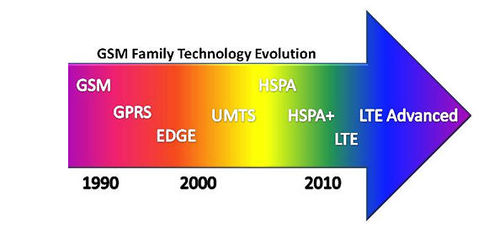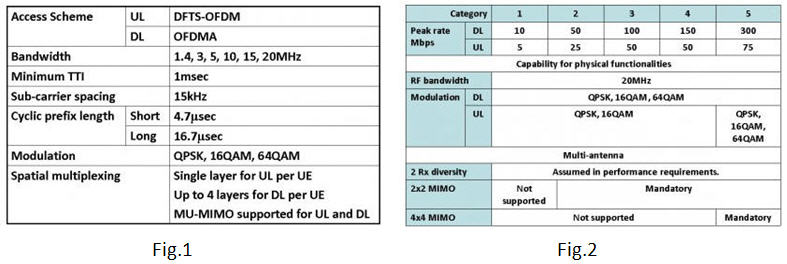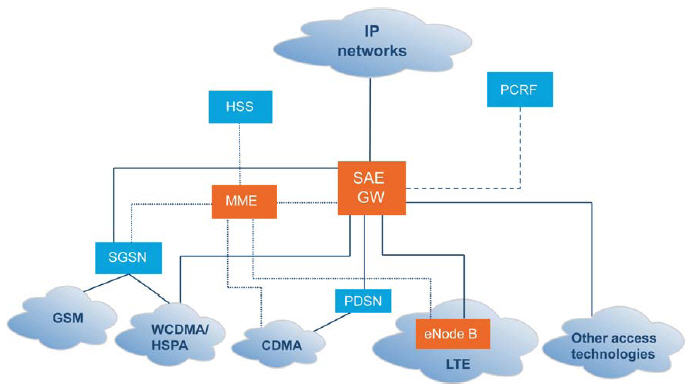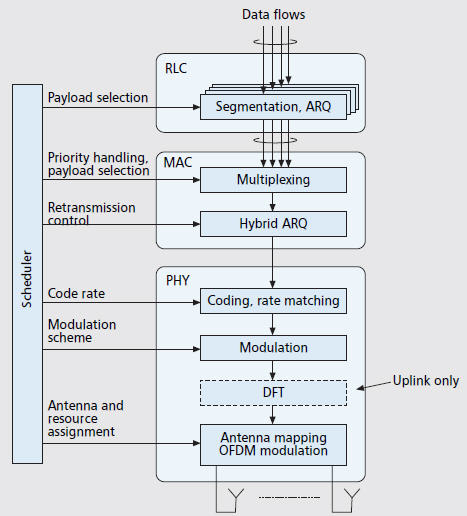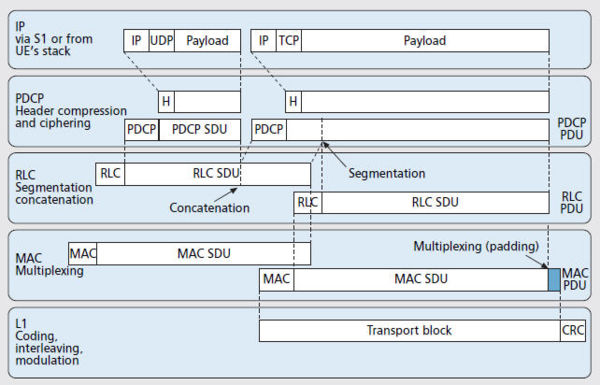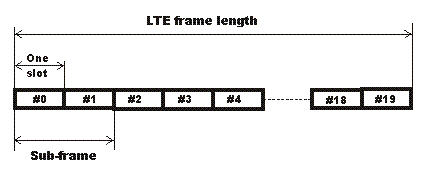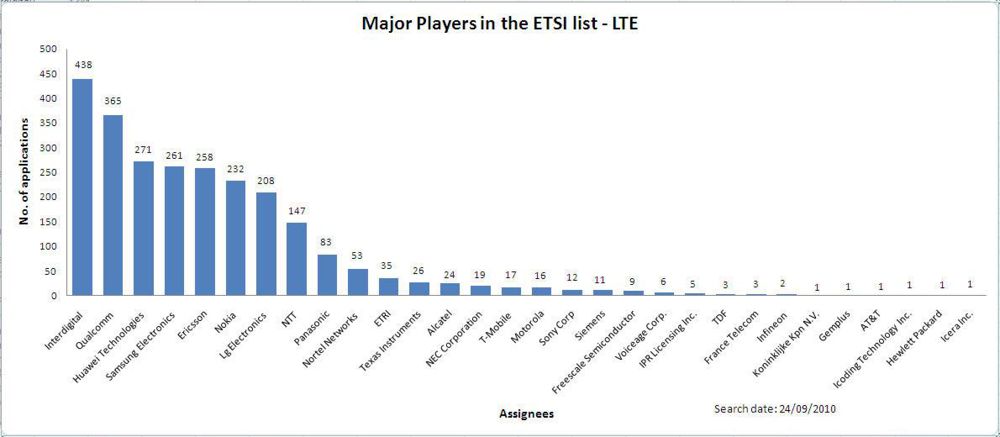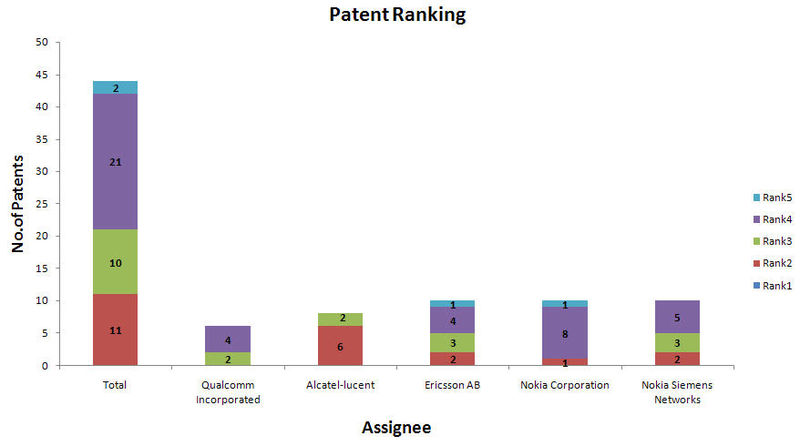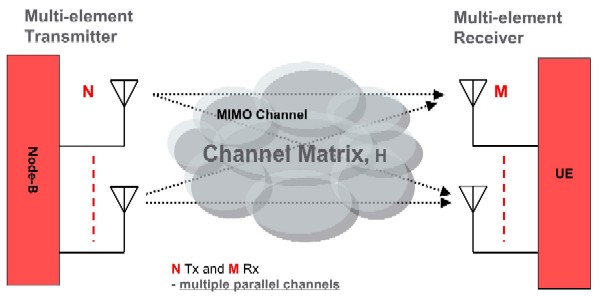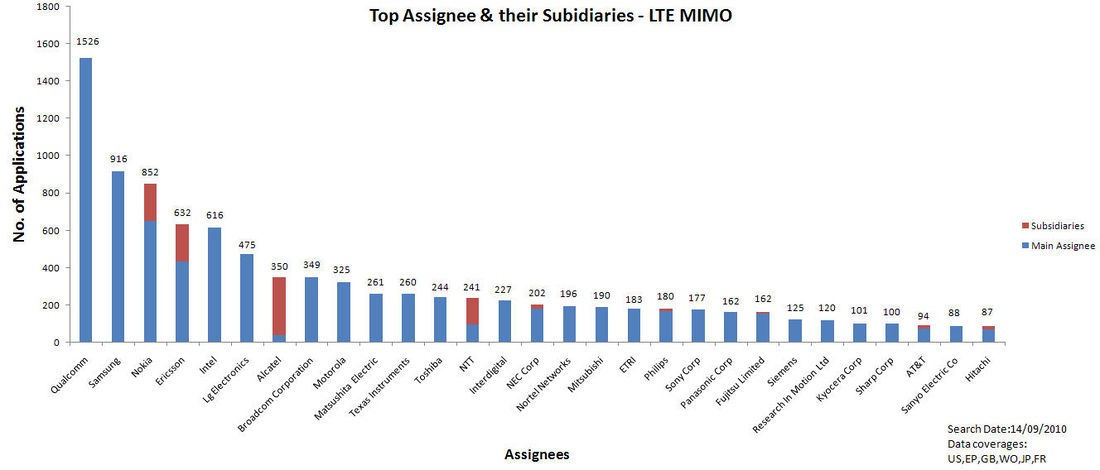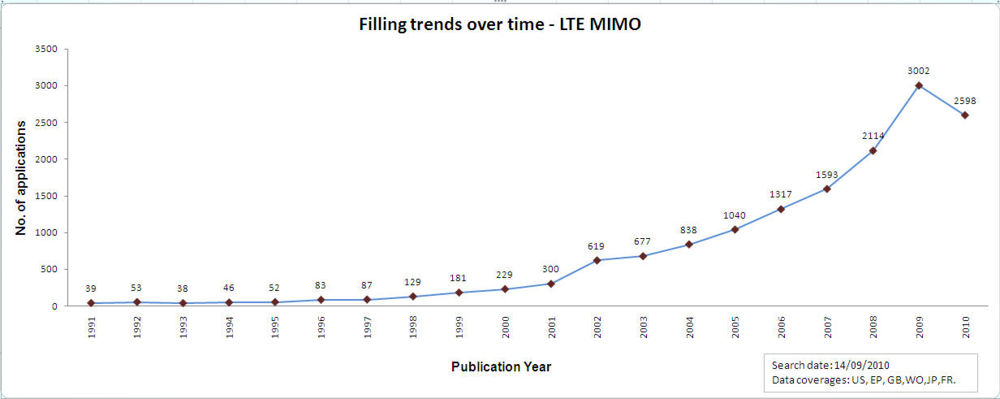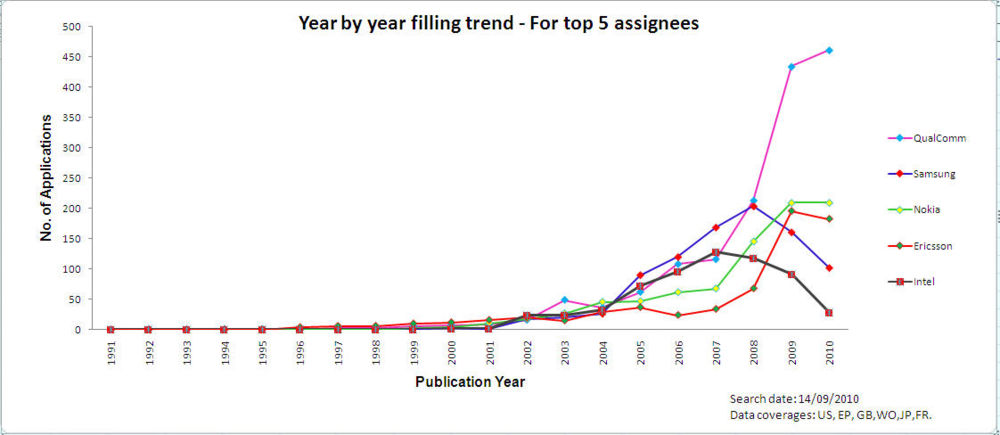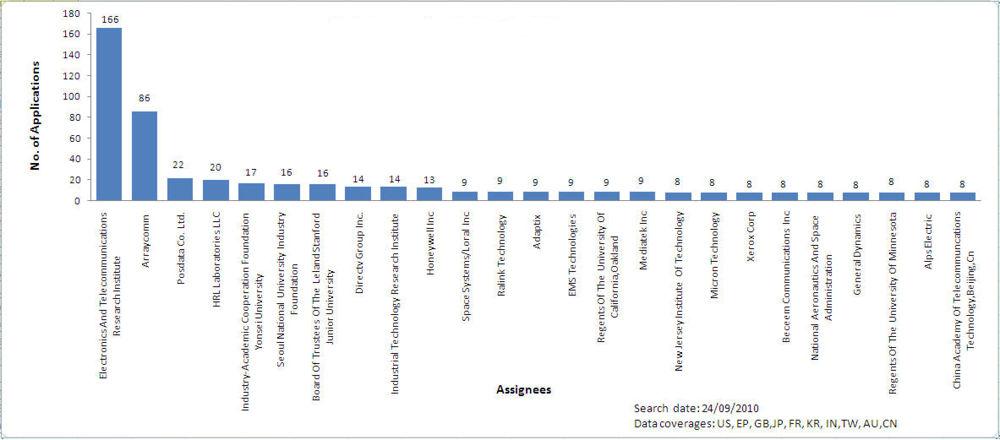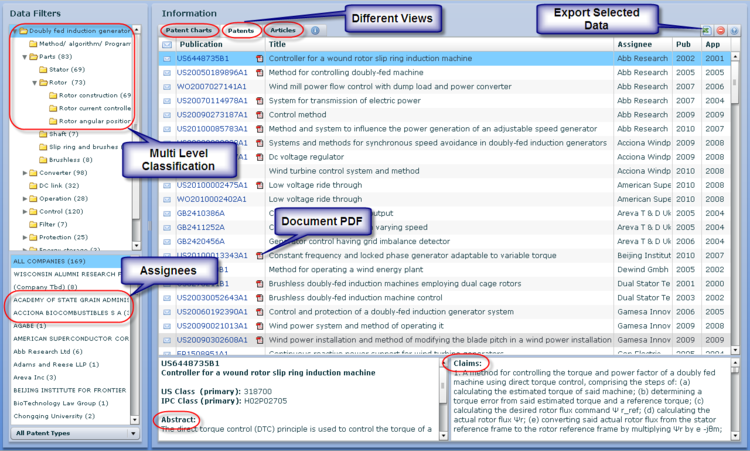LTE
This report presents a brief summary about Dolcera's capabilities in working with standards, with LTE as an example. The taxonomy covers most of the important aspects of LTE. Also presented are examples of mapping patents to standards going to the detail of graphical analysis. Analysis of IPR declarations made to ETSI, and documents uncovered by Dolcera search is also provided.
Contents
- 1 Rationale
- 2 Background description
- 3 Technical details
- 4 LTE architecture
- 5 LTE enabling technologies
- 6 Taxonomy
- 7 Major players in the ETSI list for LTE
- 8 Relevant Documents for LTE in the ETSI list
- 9 Ranking of ETSI patents
- 10 MIMO(Multiple Input Multiple Output)
- 11 Concept table for MIMO
- 12 Control patents
- 13 Search Strategy - MIMO
- 14 Company wise distribution of IP
- 15 Filing trends over the years
- 16 Year by year trends of top 5 companies
- 17 Companies with relevant IP for further analysis
- 18 Most cited documents in non-ETSI list for MIMO
- 19 Patent mapping by graphical analysis
- 20 Claim Mapping
- 21 Ranking of Non ETSI patents
- 22 Interactive Taxonomy
- 23 Dolcera Dashboard
- 24 LTE Release 8
- 25 Meeting minutes
- 26 Like this report?
- 27 References
- 28 Contact Dolcera
Rationale
- LTE is the most suited mobile technology as it provides higher data rates required for the future and is an improvement over the established GSM/EDGE/HSPA systems
- LTE is promoted by major corporates as the technology enabling future communication
- The following advantages are expected to be obtained with the realization of LTE
- Reduced cost per bit
- Increased service provisioning - more services at lower cost with better user experience
- Flexibility of use of existing and new frequency bands
- Simplified architecture, Open interfaces
- Allow for reasonable terminal power consumption
Background description
LTE (Long Term Evolution), is the latest standard in the mobile network technology that came into existence because of the growing needs of faster data rates. It is a 3rd Generation Partnership Project (3GPP), which realized this technology. LTE is an advancement to previously realized technologies such as GSM/EDGE and UMTS/HSxPA etc. Although LTE is often marketed as 4G, first-release LTE is actually a 3.9G technology since it does not fully comply with the IMT Advanced 4G requirements.
LTE-Advanced has been granted 4G compliance given the significant improvement they provide over 3G technologies [1]
Voice traffic will be supported mainly as Voice over IP (VoIP) enabling better integration with other multimedia services. LTE is being designed to be a high data rate and low latency system. LTE is also aimed at minimizing cost and power consumption while ensuring backward-compatibility and a cost effective migration from UMTS systems. LTE tutorial
Technical details
Performance requirements
LTE is expected to support different types of services including web browsing, FTP, video streaming, VoIP, online gaming, real time video, push-to-talk and push-to-view. Therefore, it is being designed to be a high data rate and low latency system as indicated by the key performance criteria shown below.
LTE architecture
Protocol stack
Data flow
The data flow through protocol stack can be shown as
LTE frame structure
In order to maintain synchronization and manage different types of information exchange that need to be carried between the base-station or eNodeB and the User Equipment (UE), LTE system has a defined LTE frame and sub frame structure for the E-UTRA or Evolved UMTS Terrestrial Radio Access
There are two types of LTE frame structure:
- Type 1: FDD systems
- The basic type 1 LTE frame has an overall length of 10 ms. This is then divided into a total of 20 individual slots. LTE sub frames then consist of two slots - in other words there are ten LTE sub frames within a frame.
- Type 2: TDD systems
- The frame structure for the type 2 frames used on LTE TDD is somewhat different. The 10 ms frame comprises two half frames, each 5 ms long. The LTE half-frames are further split into five sub frames, each 1ms long.
- The subframes may be divided into standard sub frames of special sub frames. The special sub frames consist of three fields
- DwPTS - Downlink Pilot Time Slot
- GP - Guard Period
- UpPTS - Uplink Pilot Time Slot.
LTE enabling technologies
- OFDMA (Orthogonal Frequency Division Multiple Access)
- It is used in the downlink communication of LTE as it can support high data rates
- SC-FDMA (Single Carrier FDMA)
- It is used in the uplink communication of LTE as it helps in reducing terminal power consumption
- MIMO (Multi-Input Multi-Output)
- Helps in obtaining increased data rates with usage of many antennas.
- System Architecture Evolution(SAE)
- New core network architecture to support the high-throughput / low latency LTE access system
- Simplified network architecture
- All IP network
- All services are via PS domain only, No CS domain
- Support mobility between multiple heterogeneous access system
- Fractional frequency reuse
- Helps in reusing the frequency so that spectral efficiency can be improved
Taxonomy
Major players in the ETSI list for LTE
Relevant Documents for LTE in the ETSI list
| S.No | Publication Number | Title | Filing date | Expiry date | Priority Date | Assignee/Applicant | Count of Cited Refs - Patent | Rating |
| 1 | US5754976A | Algebraic codebook with signal-selected pulse amplitude/position combinations for fast coding of speech | 7/28/1995 | 7/28/2015 | 1990-02-23 | 1992-09-10 | 1995-02-06 | 1995-07-28 | Universite de Sherbrooke, Sherbrooke, CA | 44 | 2 |
| 2 | US6724976B2 | Communication system | 12/21/2000 | 12/21/2020 | 1992-03-26 | 1992-09-25 | 1993-03-25 | 1993-09-27 | 1998-04-22 | 2000-02-16 | 2000-12-21 | Matsushita Electric Industrial Co. Ltd., Osaka, JP | 110 | 3 |
| 3 | US6633600B2 | Traffic lights in a code division multiple access (CDMA) modem | 4/24/2001 | 4/24/2021 | 1995-06-30 | 1996-06-27 | 1998-02-17 | 1999-11-22 | 2001-04-24 | InterDigital Technology Corporation, Wilmington, DE, US | 85 | 3 |
| 4 | US7190966B2 | Method and apparatus for performing an access procedure | 6/29/2005 | 6/29/2025 | 1996-06-27 | 1998-01-06 | 2000-11-22 | 2002-03-01 | 2003-03-26 | 2004-06-14 | 2005-06-29 | InterDigital Technology Corporation, Wilmington, DE, US | 91 | 4 |
| 5 | US7437177B2 | Method employed by a base station for controlling initial power ramp-up using short codes | 3/14/2008 | 3/14/2028 | 1996-06-27 | 1998-01-06 | 2000-11-22 | 2002-03-01 | 2003-03-26 | 2004-06-14 | 2005-06-29 | 2008-03-14 | InterDigital Communications Corp., Wilmington, DE, US | 190 | 4 |
Disclaimer:
- Rating is given based on claims, no.of cited patents, expiry date and priority date
- Rating is done on a scale from 1 to 5
Ranking of ETSI patents
| S.No | Patent/Publication No. | International Class (primary) | Assignee | Title | Publication Year | Priority Year(s) | Legal Status | Rank |
| 1 | US20100182939A1 | H04J000300 | Nokia Corporation | Configuration of multi-periodicity semi-persistent scheduling for time division duplex operation in a packet-based wireless communication system | 2010 | 2008 | 2009 | Docketed New Case - Ready for Examination | 2 |
| 2 | EP2181559A1 | H04W003608 | Nokia Siemens Networks | Handover of a user equipment with forwarding and reusing a user equipment configuration | 2010 | 2007 | 2008 | 2008 | Request for Examination Filed | 2 |
| 3 | EP1961141A2 | H04L000100 | Ericsson AB | Efficient channel quality reporting and link adaptation for multi-carrier broadband wireless communication | 2008 | 2005 | 2006 | 2006 | Request for Examination Filed | 2 |
| 4 | US20110029834A1 | H04L000118 | Alcatel-Lucent | Method for operating harq buffer | 2011 | 2008 | 2009 | 2009 | Docketed New Case - Ready for Examination | 2 |
| 5 | US20090086710A1 | H04J000324 | Qualcomm Incorporated | Method and apparatus for implementing lte rlc header formats | 2009 | 2007 | 2008 | Docketed New Case - Ready for Examination | 3 |
Click here to see full list of Ranking of ETSI patents
Disclaimer: Patent ranking has been done according to the following logic:
- Rank-1: Granted + LTE related (claims)
- Rank-2: Published + LTE related (claims)
- Rank-3: LTE related (Full spec )
- Rank-4: May be relevant and requires further analysis
- Rank-5: Abandoned or Expired
Note: Here a total of 44 patents from ETSI have been taken, out of which Qualcomm Incorporated has 6 patents, Alcatel-lucent has 8 patents, Ericsson AB, Nokia corporation, Nokia Siemens Networks have 10 each
MIMO(Multiple Input Multiple Output)
Multiple input multiple output (MIMO) technologies introduced in LTE such as spatial multiplexing, transmit diversity, and beamforming are key components for providing higher peak rate at a better system efficiency, which are essential for supporting future broadband data service over wireless links.In Long Term Evolution (LTE), MIMO technologies have been widely used to improve downlink peak rate, cell coverage, as well as average cell throughput.
To achieve this diverse set of objectives, LTE adopted various MIMO technologies including transmit diversity, single user (SU)-MIMO, multiuser (MU)-MIMO, closed-loop rank-1 precoding, and dedicated beamforming. MIMO in LTE
Concept table for MIMO
| S.no | MIMO | OFDMA | SCFDMA | Interference | SDMA | HARQ | Multipath | LTE | Others |
| 1 | Multiple adj input* adj multiple adj output* | OFDM | scfdma | interference near3 mitigate* | Space adj2 time adj2 transmit adj2 diversity | HARQ | Multipath near2 effect* | LTE | channel adj2 quality adj2 indication adj2 channel* |
| 2 | Distributed adj transmission adj directional adj reception | (orthogonal adj frequency adj division) near2 multiplex* | SINGLE adj CARRIER adj FREQUENCY adj DIVISION adj MULTIPLE adj ACCESS* | interference near3 cancel* | antenna adj2 multiplex* | Hybrid adj automatic adj repeat adj request | Multipath near2 propagat* | Long term evolution | CQICH |
| 3 | DTDR | ofdma | scfdm | interference near3 reduc* | SDMA | feedback adj2 mechani* | Multipath near2 phenomenon | Evolved packet system | Downlink adj2 Channel adj2 Descriptor adj2 message* |
| 4 | transmission adj2 diversit* | (orthogonal adj frequency adj division) near2 (multiple adj access) | single adj carrier adj frequency adj division adj multiplex* | interference near3 null* | Space adj2 division adj2 multiple adj2 access | Hybrid ARQ | System architecture evolution | adaptive adj2 modulation adj2 coding | |
| 5 | SFBC | discrete adj multi adj tone | SC-FDMA | Space adj2 domain adj2 multiple adj2 access | ARQ | E-UTRA* | pre adj coding*3 | ||
| 6 | Space adj2 frequency adj2 block adj coding | DMT | DFT-spread adj OFDM | plural* near2 (spatial adj streams | automatic adj repeat adj request | Evolved UMTS terrestrial radio access | per adj2 antenna adj2 rate adj2 control | ||
| 7 | SU adj2 MIMO | (adaptive ADJ modulation*) | DFT-S-OFDMA | spatial adj2 adaptation | Automatic Repeat Query | permutation adj2 mode adj2 selection | |||
| 8 | MU adj2 MIMO | sofdm | Interleaved adj FDMA | adaptive adj2 transmi* | |||||
| 9 | space adj2 time adj2 cod* | Interleaved adj Frequency adj Division adj Multiple adj Access | Bell adj2 Labs adj2 Layer adj2 Space adj2 Time | ||||||
| 10 | multiple adj antenna* | IFDMA | spatial adj2 multiplex* | ||||||
| 11 | multi adj antenna* | Discrete adj Fourier adj Transform adj Spread adj Orthogonal adj Frequency adj Multiple adj Access | |||||||
| 12 | multiple adj transmit* adj2 receive* | DFT- SOFDM | |||||||
| 13 | plural* adj2 antenna* | ||||||||
| 14 | atleast adj2 two adj2 antenna* | ||||||||
| 15 | layer adj map*4 | ||||||||
| 16 | beam adj2 steer* | ||||||||
| 17 | smart adj antenna*1 | ||||||||
| 18 | spatial adj multiplex*3 | ||||||||
| 19 | multiple adj transmit* adj antenna*1 | ||||||||
| 20 | multiple adj receive* adj antenna*1 | ||||||||
| 21 | Adaptive adj2 antenna adj2 steer* | ||||||||
| 22 | beam adj2 forming | ||||||||
| 23 | eigenmode adj2 multiplex* |
Control patents
- Control patents are mostly used
- to prepare concepts
- to search classes, and
- to verify the search strategy
- Control patents are found by running a query with narrow keywords, and in this process litigation's and file wrappers are also looked at.
| S.No | Patent/Publication No. | Title | Abstract |
| 1 | US6873606 | Rate adaptive transmission scheme for MIMO systems | A rate adaptive transmission scheme for MIMO systems, which can transmit a variable number of data symbol streams, provide transmit diversity for each data symbol stream, and fully utilize the total transmit power of the system and the full power of each antenna. In one method, at least one data symbol stream is received for transmission from a plurality of antennas. Each data symbol stream is scaled with a respective weight corresponding to the amount of transmit power allocated to that stream. The scaled data symbol stream(s) are multiplied with a transmit basis matrix to provide a plurality of transmit symbol streams for the plurality of antennas. The transmit basis matrix (e.g., a Walsh-Hadamard matrix or a DFT matrix) is defined such that each data symbol stream is transmitted from all antennas and each transmit symbol stream is transmitted at (or near) the full power for the associated antenna. |
| 2 | US7233625 | Preamble design for multiple input--multiple output (MIMO), orthogonal frequency division multiplexing (OFDM) system | One or more preambles are inserted into frames of Orthogonal Frequency Multiplexing (OFDM)-Multiple Input, Multiple Output (MIMO) signals. The preamble is received by the antennas of a receiver, decoded and compared to known values to provide synchronization, framing, channels estimation, offsets and other corrections to the transmitted signal. |
| 3 | US7248559 | Scattered pilot pattern and channel estimation method for MIMO-OFDM systems | A method and apparatus are provided for reducing the number of pilot symbols within a MIMO-OFDM communication system, and for improving channel estimation within such a system. For each transmitting antenna in an OFDM transmitter, pilot symbols are encoded so as to be unique to the transmitting antenna. The encoded pilot symbols are then inserted into an OFDM frame to form a diamond lattice, the diamond lattices for the different transmitting antennae using the same frequencies but being offset from each other by a single symbol in the time domain. At the OFDM receiver, a channel response is estimated for a symbol central to each diamond of the diamond lattice using a two-dimensional interpolation. The estimated channel responses are smoothed in the frequency domain. The channel responses of remaining symbols are then estimated by interpolation in the frequency domain. |
| 4 | US7548506 | System access and synchronization methods for MIMO OFDM communications systems and physical layer packet and preamble design | A method and apparatus are provided for performing acquisition, synchronization and cell selection within an MIMO-OFDM communication system. A coarse synchronization is performed to determine a searching window. A fine synchronization is then performed by measuring correlations between subsets of signal samples, whose first signal sample lies within the searching window, and known values. The correlations are performed in the frequency domain of the received signal. In a multiple-output OFDM system, each antenna of the OFDM transmitter has a unique known value. The known value is transmitted as pairs of consecutive pilot symbols, each pair of pilot symbols being transmitted at the same subset of sub-carrier frequencies within the OFDM frame. |
| 5 | US7120395 | MIMO communications | The present invention allows a wireless communication system, such as a base station, to select N antennas from an associated group of M antennas for transmitting multiple streams of data to a given user. Based on the channel conditions between the M antennas of the wireless communication system and the multiple antennas at the receiver, the N antennas to use for transmission are selected to enhance channel capacity, signal-to-noise ratios, or a combination thereof. The channel conditions are measured at the receiver, and may be sent back to the wireless communication system for processing or may be processed at the receiver, wherein instructions are transmitted back to the wireless communication system to control antenna selection. |
Click here to see full list of LTE control patents
Search Strategy - MIMO
Company wise distribution of IP
Note:
- The subsidiaries of Nokia includes : Nokia Telecommunication Oy and Nokia Siemens.
- The subsidiaries of Ericsson/LM Ericsson includes : Ericsson GE Mobile Communications Inc, ST-Ericsson, Sony Ericcson.
- The Subsidiaries of Alcatel includes : Alcatel-Lucent, Alcatel Shangai bell company, Alcatel Transmission, Lucent Technologies, CIT Alcatel.
- The Subsidiaries of NTT includes : Nippondenso Co, NTT Docomo.
- The subsidiaries of NEC Corp includes : NEC Access technica Ltd.,NEC Laboratories.
- The subsidiaries of Phlilps includes : Philips Electronics, Philips Intellectual property & standards.
- The subsidiaries of Fujistu includes : Fujistu ten Limited, Fujitsu Microelectronics Limited.
- The subsidiaries of AT&T includes : AT&T Mobility, AT & T BLS Intellectual Property, AT&T Bell Laboratories, AT&T Wireless Services Inc., BellSouth Intellectual Property Corporation.
Filing trends over the years
Year by year trends of top 5 companies
Companies with relevant IP for further analysis
Disclaimer 1: Here primarily, companies with an average annual revenue less than 400 million USD are considered. In addition to these, some big companies whose primary interest is not LTE and those which provide IP licensing are also considered.
Disclaimer 2 :The above graph is based on raw data available with us. Some of the patents may not be relevant
Most cited documents in non-ETSI list for MIMO
| S.No | Patent/Publication No. | Title | Priority Date | Assignee/Applicant | Count of Citing Patents |
| 1 | US5541955A | Adaptive data rate modem | 1992-11-06 | 1995-04-28 | Pericle Communications Company | 272 |
| 2 | US5999561A | Direct sequence spread spectrum method, computer-based product, apparatus and system tolerant to frequency | 1997-05-20 | 1997-07-08 | 1997-09-15 | Sanconix Inc | 161 |
| 3 | US5752164A | Autonomous remote measurement unit for a personal communications service system | 1992-04-27 | 1995-04-25 | American PCS L | 146 |
| 4 | US4441180A | Service integrated communication transmission and interchange system | 1979-06-01 | 1980-05-30 | Licentia Patent Verwaltungs GmbH | 134 |
| 5 | US6072994A | Digitally programmable multifunction radio system architecture | 1995-8-31 | Northrop Grumman Corporation | 133 |
| 6 | US6314147B1 | Two-stage CCI/ISI reduction with space-time processing in TDMA cellular networks | 1997-11-04 | 1998-11-04 | The Board of Trustees of the Leland Stanford Junior University | 132 |
| 7 | US5859878A | Common receive module for a programmable digital radio | 1995-8-31 | Northrop Grumman Corporation | 131 |
| 8 | US5345471A | Ultra-wideband receiver | 1993-12-4 | The Regents of the University of California | 130 |
| 9 | US5694134A | Phased array antenna system including a coplanar waveguide feed arrangement | 1992-12-01 | 1993-10-21 | 1994-01-14 | Superconducting Core Technologies, Inc. | 128 |
| 10 | US5347286A | Automatic antenna pointing system based on global positioning system (GPS) attitude information | 1992-02-13 | 1993-03-19 | Trimble Navigation Limited | 115 |
Patent mapping by graphical analysis
| Sno. | Patent/Publication No. | Title | Figure analyzed | Analyzed result | Standard mapped into |
| 1 | US20070217538A1 | Systems and methods for improving performance of multiple spatial communication channels | Figure 4 | DL data rate: 220 M bps for 3x3 advanced MIMO-SVD | LTE release 8, category 4 |
| 2 | US20090232229A1 | Device, system and method of resource allocation in a wireless network | Figure 2A | DL data rate: 210 M bps for a 2x2 MIMO at cell centre | LTE release 8, category 5 |
Claim Mapping
Process Flow
Sample claim charting
| S.No. | Patent/Publication No. | Claim Language | Relevant Section in LTE release 8 | Technical Comments |
| 1 | US20090318127 | Claim1 | 4.2.1 PDCP structure 3GPP TS 36.323 V8.6.0 (2009-06) Packet Data Convergence Protocol (PDCP) specification (Release 8) | The PDCP layer receives data from the lower layer i.e RLC layer |
| A data communication method in a wireless communication system, the method comprising: receiving, from a lower layer, | 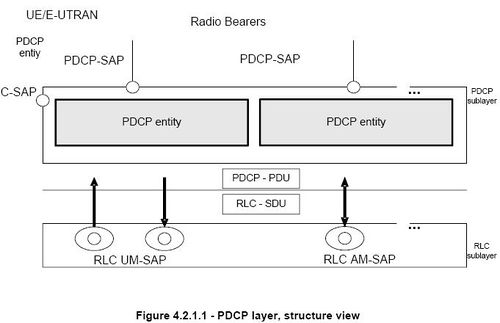
| |||
| a data unit having a sequence number; storing the received data unit in a buffer; | 4.3.2 Services expected from lower layers 3GPP TS 36.323 V8.6.0 (2009-06) Packet Data Convergence Protocol (PDCP) specification (Release 8) | The data from the MAC buffer is delivered to the PDCP layer in sequence (based on sequence number) through the RLC layer | ||
| in-sequence delivery, except at re-establishment of lower layers; | ||||
| determining whether the sequence number of the received data unit is equal to a sequence number +1 from a sequence number of a last delivered data unit; | 5.1.2 DL Data Transfer Procedures 3GPP TS 36.323 V8.6.0 (2009-06) Packet Data Convergence Protocol (PDCP) specification (Release 8) | The next PDCP sequence no. is always set as previous PDCP sequence no. + 1 | ||
| set Next_PDCP_RX_SN to the received PDCP SN + 1; | ||||
| and delivering, in ascending order, all stored data units with consecutively associated sequence numbers greater than or equal to the sequence number of the received data unit based on the determining step. | 5.1.2 DL Data Transfer Procedures 3GPP TS 36.323 V8.6.0 (2009-06) Packet Data Convergence Protocol (PDCP) specification (Release 8) | The data unit delivered to the upper layers in an ascending order based on the count value | ||
| deliver to upper layers in ascending order of the associated COUNT value | ||||
| Claim2 | 4.2.1 PDCP structure 3GPP TS 36.323 V8.6.0 (2009-06) Packet Data Convergence Protocol (PDCP) specification (Release 8) | The layer below the PDCP layer is RLC layer | ||
| The method of claim 1, wherein the lower layer is a Radio Link Control (RLC) layer. | 
| |||
| Claim3 | 4.2.2 PDCP entities 3GPP TS 36.323 V8.6.0 (2009-06) Packet Data Convergence Protocol (PDCP) specification (Release 8) | Steps of determining and delivering PDCP data units are performed in a PDCP entity | ||
| The method of claim 1, wherein the steps of determining and delivering are performed in a Packet Data Convergence Protocol (PDCP) entity. | 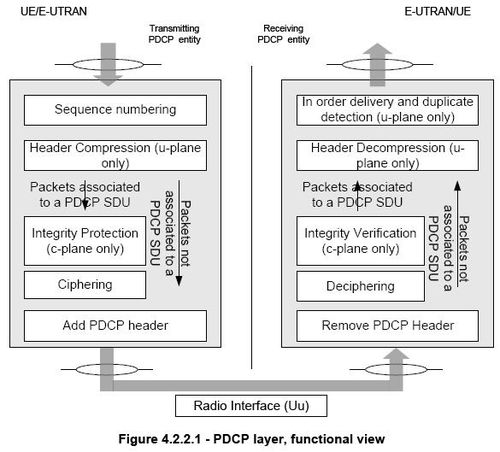
| |||
| Claim4 | 4.2.2 PDCP entities 3GPP TS 36.323 V8.6.0 (2009-06) Packet Data Convergence Protocol (PDCP) specification (Release 8) | On the PDCP SDU, numbering sequence is checked, header compression is done and send to the upper layers | ||
| The method of claim 1, wherein the data unit is a PDCP Service Data Unit (SDU). | 
| |||
| Claim5 | 4.4 Functions 3GPP TS 36.323 V8.6.0 (2009-06) Packet Data Convergence Protocol (PDCP) specification (Release 8) | SDU is received through a re-establishment of lower layer i.e RLC layer | ||
| The method of claim 1, wherein the data unit is received through a RLC re-establishment. | duplicate elimination of lower layer SDUs at re-establishment of lower layers for radio bearers mapped on RLC AM | |||
| Claim6 | 5.1.2 DL Data Transfer Procedures 3GPP TS 36.323 V8.6.0 (2009-06) Packet Data Convergence Protocol (PDCP) specification (Release 8) | Header decompression or deciphering is done between the stages of receiving and storing the PDCP data units | ||
| The method of claim 1, wherein a header decompression or a deciphering is performed between the receiving step and the storing step. | if received PDCP SN > Next_PDCP_RX_SN: - decipher the PDCP PDU as specified in the subclause 5.6, using COUNT based on RX_HFN - 1 and the received PDCP SN; -- -- if the PDCP PDU has not been discarded in the above: - perform deciphering and header decompression (if configured) for the PDCP PDU as specified in the subclauses 5.6 and 5.5.5, respectively; - if a PDCP SDU with the same PDCP SN is stored: - discard this PDCP SDU; - else: - store the PDCP SDU; --- --- | |||
| Claim7 | 5.1.2 DL Data Transfer Procedures 3GPP TS 36.323 V8.6.0 (2009-06) Packet Data Convergence Protocol (PDCP) specification (Release 8) | The next PDCP sequence no. is always set as previous PDCP sequence no. + 1 | ||
| The method of claim 1, wherein the sequence number +1 indicates a sequence number that is immediately subsequent to the sequence number of the last delivered data unit. | set Next_PDCP_RX_SN to the received PDCP SN + 1; | |||
| Claim8 | ||||
| The method of claim 1, wherein the sequence number +1 indicates a next sequence number from the sequence number of the last delivered data unit. | ||||
| Claim9 | 5.1.2 DL Data Transfer Procedures 3GPP TS 36.323 V8.6.0 (2009-06) Packet Data Convergence Protocol (PDCP) specification (Release 8) | The last delivered data unit to an upper layer is named as Last_Submitted_PDCP_RX_SN | ||
| The method of claim 1, further comprising: setting a sequence number of a last data unit delivered to an upper layer as a `LAST`. | set Last_Submitted_PDCP_RX_SN to the PDCP SN of the last PDCP SDU delivered to upper layers |
- Click here to download the excel sheet.
- Click here to download the release for 3GPP TS 36.323 V8.6.0 (2009-06) Packet Data Convergence Protocol (PDCP) specification (Release 8)
Ranking of Non ETSI patents
| Sno. | Patent/Publication No. | US Class (primary) | Title | Publication Year | Priority Year(s) | Legal status | Rank |
| 1 | US7548730B2 | 375267 | Systems and methods for improving performance of multiple spatial communication channels | 2007 | 2006 | Patented Case | 1 |
| 2 | US20090232229A1 | 375260 | Device, system and method of resource allocation in a wireless network | 2009 | 2008 | Docketed New Case - Ready for Examination | 2 |
| 3 | US20080187066A1 | 375267 | Detection method and apparatus for a multi-stream MIMO | 2008 | 2007 | Non Final Action Mailed | 2 |
| 4 | US7796546B2 | 370315 | Apparatus and method for supporting multiple links in a network using frequency bands | 2007 | 2006 | Patented Case | 4 |
Disclaimer: Patent ranking has been done according to the following logic:
- Rank-1: Granted + LTE related (claims)
- Rank-2: Published + LTE related (claims)
- Rank-3: LTE related (Full spec )
- Rank-4: May be relevant and requires further analysis
- Rank-5: Abandoned or Expired
Interactive Taxonomy
Note:This interactive taxonomy consists of 131 sample documents.
Dolcera Dashboard
Dashboard Link
The Dashboard is Dolcera's visualization platform to present the organized patent landscape
- Best viewed in Internet explorer 6 and higher versions
- To view dashboard you would require a flash player. Kindly install a flash player if its not installed in your system
| LTE - Dashboard |
- Note1: Use the following credentials to view the dashboard 1.1
- Username: demo@dolcera.com
- Password: demo123
- Note2: A total of 131 patents were considered for the creation of the sample dashboard
LTE Release 8
Meeting minutes
Click here for the meeting minutes.
Like this report?
This is only a sample report with brief analysis
Dolcera can provide a comprehensive report customized to your needs
References
- Stefania Sesia, Issam Toufik, and Matthew Baker, "LTE - The UMTS Long Term Evolution - From Theory to Practice", John Wiley & Sons, 2009,
- Martin Sauter, "From GSM to LTE - An Introduction to Mobile Networks and Mobile Broadband", John Wiley & Sons, 2010,
- Erik Dahlman, Stefan Parkvall, Johan Sköld, Per Beming, "3G Evolution - HSPA and LTE for Mobile Broadband", 2nd edition, Academic Press, 2008,
- Mustafa Ergen, "Mobile Broadband - Including WiMAX and LTE", Springer, NY, 2009
- Borko Furht, Syed A. Ahson, "Long Term Evolution: 3GPP LTE Radio And Cellular Technology", CRC Press, 2009,
- Ezio Biglieri, Robert calderbank, Anthony Constantinides et.al ,"MIMO Wireless Communications" Cambridge University Press, 2007
Contact Dolcera
| Samir Raiyani |
|---|
| Email: info@dolcera.com |
| Phone: +1-650-269-7952 |
